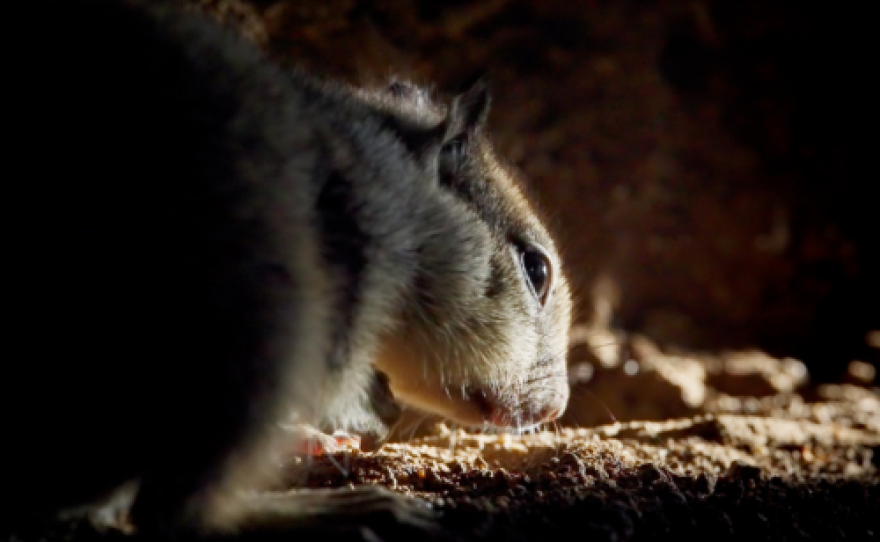Squirrels are a common sight you might not think twice about. But researchers like UC Davis behavioral ecologist Sonja Wild say there’s a lot they can teach us.
For the last few years, she’s helped lead research efforts as part of UC Davis’s Long-term Behavioral Ecology of California Ground Squirrels Project, which monitors a population in Briones Regional Park in the Bay Area. The native squirrel can be found throughout California, as well as a little into Southern Oregon and the Baja California peninsula.
The study is in its 13th year, and Wild says the team behind it has collected data on 1,300 different squirrels since it began.
“We paint little marks on their backs so we can tell them apart from afar via binoculars, and then they get a little microchip so we can recognize them remotely using antenna,” Wild says. “This is kind of like the basis of the research that allows us to do experiments.”
When discussing California native wildlife, the conversation often surrounds species that are struggling to survive alongside human presence. But Wild says ground squirrels are different. She says this native species is highly adaptable, which is why it’s continued to thrive despite big changes to their environment.
CapRadio spoke with Wild about what ground squirrels can tell us about surviving amid human-caused changes and the surprising ways they’ve learned to adapt.
This interview has been edited for clarity and length.
What kinds of squirrels should someone in the Sacramento region expect to see?
Around here, you'll see two types of squirrels. There's the tree squirrels that you see on a lot of campuses, also in the middle of the city and urban parks. These squirrels are basically adapted morphologically to climbing. So, you will see they're kind of slim, built aerodynamically.
The ground squirrel, as the name suggests, is one that spends most of their day on the ground and underground, so they dig burrows. They're a little more plump, more sturdy.
How you recognize them specifically and tell them apart from other species is they have a sort of brownish color with silver sprinkles. They have relatively bushy tails for ground squirrels. And what is very particular about them is that the fur around their eye is really white. So, it looks like they're wearing eyeliner, and that is something that the tree squirrels do not have.
So, if you see a squirrel, look in their eyes.
They’re also a California native species that’s doing pretty well, right?
The California ground squirrel is a species of least concern, so they have really very little risk of extinction. So yes, they're doing pretty well in a variety of habitats, more natural settings … but also urban parks.
They're also super behaviorally flexible and have really flexible diets. They eat a lot of seeds and fresh greens, but they will happily go through human trash and eat the rest of your hamburger.
For many animal species that do well in human habitats, what they have in common is that they are very flexible.
So instead of being very rigid in like, ‘I need a natural tree hole to find shelter,’ they’re like, ‘I'm just going to use this mailbox to sleep in.’
What’s an example of this adaptability that you’ve witnessed?
We have seen this in an amazing but also a little gruesome event in the 12th year of our long-term study. In 2024 in summer, parts of California, including our field side, experienced this unprecedented boom in California voles. All of a sudden, they were everywhere. There were hundreds of voles running around our field site and park visitors kept asking, ‘What is going on here?’
And all of a sudden a student came to me and was like, ‘Huh, is it normal that the squirrels attack these voles?’ And I'm like, ‘I don't think so.’ Like, I've never seen this before. And she was like, ‘Yeah, I took a video,’ and I looked at the video, and I couldn't believe my eyes. It was shocking.
From that day on, we all of a sudden saw this happening again and again and again. So, over the next three or four weeks, we observed 74 interactions of squirrels with voles. Over 20 times they actively hunted these voles like a predator.
I guess something to learn from the squirrels is really: Make do with the resources given to you, even if it ends up being California voles.
I think most people feel pretty familiar with squirrels. But what’s something you think might surprise people about them?
I think one really cool aspect is the snake interaction. One of the main predators of the California ground squirrel are rattlesnakes.
They mainly prey on the young while they're still in their burrows. And the adult ground squirrels have developed really amazing behavioral responses and physiological responses to cope with those snakes.
It turns out in populations that have been exposed to snakes evolutionary speaking, adults have developed a resistance against the venom. But only adult squirrels, so the juveniles are still vulnerable. So, the adults might actually pick a fight with a rattlesnake to defend their young.
It's amazing to see this tiny little squirrel walking up to this solid rattlesnake and trying to chase it away.
If they find a snake skin, like a skin that the snake has been shedding, they will often chew on it and then lick their own fur to disguise their scent. Mothers will also lick their offspring to disguise the scent in the burrow, so that the snake might be less likely to find them.
As the long-term UC Davis study on ground squirrels continues, what are you most interested in learning more about?
I'm particularly interested in how differences in personality affect how these squirrels adapt to human presence. And often, when we look at how animals are affected by human presence, we think about the vulnerable species.
It's very difficult in these species, often, to collect high-resolution data on individuals — on their stress physiology, on their behavior, on their personality traits, to really understand why some animals do better in human presence while others might perish.
My research is kind of turning this upside down and taking an organism that has prevailed in these human-disturbed areas. Learning about these squirrels might just tell us a lot about the more vulnerable species, where we're not able to collect that kind of high-resolution data. So, the California ground squirrel is really a model system that helps us inform conservation of more vulnerable species.





